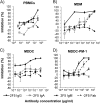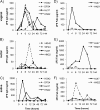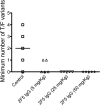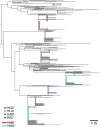Neutralizing IgG at the portal of infection mediates protection against vaginal simian/human immunodeficiency virus challenge
- PMID: 23966410
- PMCID: PMC3807318
- DOI: 10.1128/JVI.01361-13
Neutralizing IgG at the portal of infection mediates protection against vaginal simian/human immunodeficiency virus challenge
Abstract
Neutralizing antibodies may have critical importance in immunity against human immunodeficiency virus type 1 (HIV-1) infection. However, the amount of protective antibody needed at mucosal surfaces has not been fully established. Here, we evaluated systemic and mucosal pharmacokinetics (PK) and pharmacodynamics (PD) of 2F5 IgG and 2F5 Fab fragments with respect to protection against vaginal challenge with simian-human immunodeficiency virus-BaL in macaques. Antibody assessment demonstrated that 2F5 IgG was more potent than polymeric forms (IgM and IgA) across a range of cellular and tissue models. Vaginal challenge studies demonstrated a dose-dependent protection for 2F5 IgG and no protection with 2F5 Fab despite higher vaginal Fab levels at the time of challenge. Animals receiving 50 or 25 mg/kg of body weight 2F5 IgG were completely protected, while 3/5 animals receiving 5 mg/kg were protected. In the control animals, infection was established by a minimum of 1 to 4 transmitted/founder (T/F) variants, similar to natural human infection by this mucosal route; in the two infected animals that had received 5 mg 2F5 IgG, infection was established by a single T/F variant. Serum levels of 2F5 IgG were more predictive of sterilizing protection than measured vaginal levels. Fc-mediated antiviral activity did not appear to influence infection of primary target cells in cervical explants. However, PK studies highlighted the importance of the Fc portion in tissue biodistribution. Data presented in this study may be important in modeling serum levels of neutralizing antibodies that need to be achieved by either vaccination or passive infusion to prevent mucosal acquisition of HIV-1 infection in humans.
Figures










Similar articles
-
Defense-in-depth by mucosally administered anti-HIV dimeric IgA2 and systemic IgG1 mAbs: complete protection of rhesus monkeys from mucosal SHIV challenge.Vaccine. 2015 Apr 21;33(17):2086-95. doi: 10.1016/j.vaccine.2015.02.020. Epub 2015 Mar 11. Vaccine. 2015. PMID: 25769884 Free PMC article.
-
Cellular immunity elicited by human immunodeficiency virus type 1/ simian immunodeficiency virus DNA vaccination does not augment the sterile protection afforded by passive infusion of neutralizing antibodies.J Virol. 2003 Oct;77(19):10348-56. doi: 10.1128/jvi.77.19.10348-10356.2003. J Virol. 2003. PMID: 12970419 Free PMC article.
-
Protection of macaques against vaginal transmission of a pathogenic HIV-1/SIV chimeric virus by passive infusion of neutralizing antibodies.Nat Med. 2000 Feb;6(2):207-10. doi: 10.1038/72318. Nat Med. 2000. PMID: 10655111
-
Passive transfer studies to elucidate the role of antibody-mediated protection against HIV-1.Vaccine. 2002 May 6;20(15):1922-5. doi: 10.1016/s0264-410x(02)00068-3. Vaccine. 2002. PMID: 11983246 Review.
-
Fc receptor-mediated antiviral antibodies.Curr Opin HIV AIDS. 2009 Sep;4(5):388-93. doi: 10.1097/COH.0b013e32832f0a89. Curr Opin HIV AIDS. 2009. PMID: 20048702 Free PMC article. Review.
Cited by
-
A long-acting integrase inhibitor protects female macaques from repeated high-dose intravaginal SHIV challenge.Sci Transl Med. 2015 Jan 14;7(270):270ra4. doi: 10.1126/scitranslmed.3010298. Sci Transl Med. 2015. PMID: 25589630 Free PMC article.
-
Broadly Neutralizing Antibodies Display Potential for Prevention of HIV-1 Infection of Mucosal Tissue Superior to That of Nonneutralizing Antibodies.J Virol. 2016 Dec 16;91(1):e01762-16. doi: 10.1128/JVI.01762-16. Print 2017 Jan 1. J Virol. 2016. PMID: 27795431 Free PMC article.
-
Importance of Fc-mediated functions of anti-HIV-1 broadly neutralizing antibodies.Retrovirology. 2018 Aug 22;15(1):58. doi: 10.1186/s12977-018-0438-x. Retrovirology. 2018. PMID: 30134945 Free PMC article. Review.
-
Systemic and topical use of monoclonal antibodies to prevent the sexual transmission of HIV.AIDS. 2017 Jul 17;31(11):1505-1517. doi: 10.1097/QAD.0000000000001521. AIDS. 2017. PMID: 28463876 Free PMC article. Review.
-
Conformational antigenic heterogeneity as a cause of the persistent fraction in HIV-1 neutralization.Retrovirology. 2023 May 27;20(1):9. doi: 10.1186/s12977-023-00624-9. Retrovirology. 2023. PMID: 37244989 Free PMC article.
References
-
- Haase AT. 2005. Perils at mucosal front lines for HIV and SIV and their hosts. Nat. Rev. Immunol. 5:783–792 - PubMed
-
- Baba TW, Liska V, Hofmann-Lehmann R, Vlasak J, Xu W, Ayehunie S, Cavacini LA, Posner MR, Katinger H, Stiegler G, Bernacky BJ, Rizvi TA, Schmidt R, Hill LR, Keeling ME, Lu Y, Wright JE, Chou TC, Ruprecht RM. 2000. Human neutralizing monoclonal antibodies of the IgG1 subtype protect against mucosal simian-human immunodeficiency virus infection. Nat. Med. 6:200–206 - PubMed
-
- Hessell AJ, Rakasz EG, Poignard P, Hangartner L, Landucci G, Forthal DN, Koff WC, Watkins DI, Burton DR. 2009. Broadly neutralizing human anti-HIV antibody 2G12 is effective in protection against mucosal SHIV challenge even at low serum neutralizing titers. PLoS Pathog. 5:e1000433.10.1371/journal.ppat.1000433 - DOI - PMC - PubMed
-
- Mascola JR, Lewis MG, Stiegler G, Harris D, VanCott TC, Hayes D, Louder MK, Brown CR, Sapan CV, Frankel SS, Lu Y, Robb ML, Katinger H, Birx DL. 1999. Protection of macaques against pathogenic simian/human immunodeficiency virus 89.6PD by passive transfer of neutralizing antibodies. J. Virol. 73:4009–4018 - PMC - PubMed
-
- Mascola JR, Stiegler G, VanCott TC, Katinger H, Carpenter CB, Hanson CE, Beary H, Hayes D, Frankel SS, Birx DL, Lewis MG. 2000. Protection of macaques against vaginal transmission of a pathogenic HIV-1/SIV chimeric virus by passive infusion of neutralizing antibodies. Nat. Med. 6:207–210 - PubMed
Publication types
MeSH terms
Substances
Grants and funding
LinkOut - more resources
Full Text Sources
Other Literature Sources
Medical
Molecular Biology Databases
Miscellaneous

